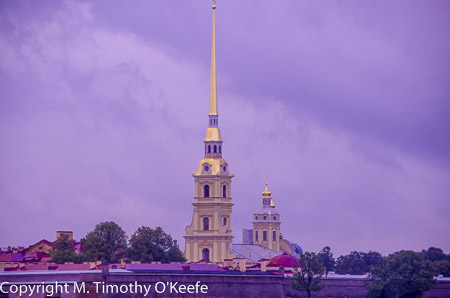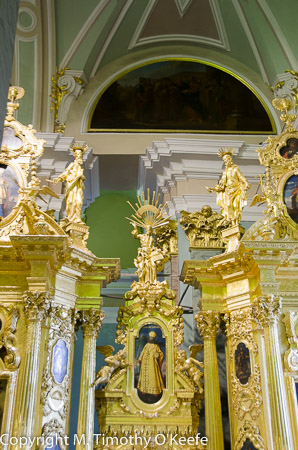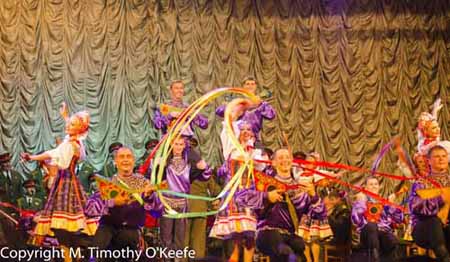Where St. Petersburg Originated
Although yesterday afternoon was cloudy, it was still good weather. Now on our third and last day, we have drizzling rain and a sky so dark it feels like twilight. We identify with a favorite St. Petersburg saying about summer weather: “Nine months of expectation, three months of disappointment.”
Our morning excursion is called the highlights of St. Petersburg, which includes brief a drive-by of two of the cathedrals we visited yesterday. Our main interest is the city’s oldest landmark, the Peter and Paul Fortress constructed in the shaped of a six-pointed star on Rabbit (Hare) Island.
Our guide admits that although St. Petersburg may be a splendid city now, when the Peter and Paul fortress was built– the first structure built here–no Russians wanted to live in the area. If the low swampy terrain and pesky summer mosquitoes weren’t bad enough, there was the added problem of wolves attacking and eating people. So, she continues, most of the early residents were forced to live here, including the nobility. No wonder many of their descendants find it difficult to smile.
 Peter and Paul Fortress on a dreary St. Petersburg day
Peter and Paul Fortress on a dreary St. Petersburg day
As our bus approaches Peter and Paul Fortress, I scan the sand beach near the fort wall. It’s deserted today but on a sunny day this beach can be packed by those eager to soak up the sun when temperatures may seem uncomfortably cool. But for those who experience only 20 hours of sunlight in December and January and whose daily high temperature from November through February stays several degrees below freezing , these hardy people have a different understanding of what it means to be cold. There is an obvious irony that the average winter low here is 15 degrees, when in St. Petersburg, FL, it’s 74 degrees. Florida’s St. Petersburg was named after this Russian city, in 1888, by Russian railroad builder Piotr Dementyev (Peter Demens) who was born in frosty St. Petersburg, Russia.
Peter and Paul Cathedral
Peter the Great began construction of the Peter and Paul Fortress in 1703 to defend the city from attack during the Russian war with Sweden (1700-1721) . When the stronghold was completed in 1740, the Swedes were long subdued and Peter the Great was dead. However, the fort did not sit idle during this time. As early as 1720, it was the barracks for the city’s garrison as well as a place to store political prisoners.
The fort’s main attraction is the Cathedral of Saints Peter and Paul. The cathedral’s towering 400-foot high golden spire is one of the city’s most noticeable landmarks. There are other attractions besides the cathedral: exhibits about St. Petersburg’s history and Russian space flight and a tour of the once dreaded prison cells of Trubetskoy Bastion. Following a tradition originated by the Tsars, the fort fires a cannon at noon each day.
 Interior of Peter and Paul Cathedral
Interior of Peter and Paul Cathedral
Our tour is limited primarily to the Peter and Paul Cathedral, not that the weather would allow us to spend much time walking around outside. The cathedral alone could consume a good part of a morning but we have half that time. The cathedral may be several hundred years old but it obviously was maintained well by Russian nobility and apparently by the Soviet government.
In fact, the radiant golden iconostasis with its 43 icons appears so new it could be recently installed. The paintings have been refurbished regularly, which explains why they are so bright, and deteriorating items such as the church doors were replaced.
An unusual feature of the church is its pulpit, used only a single time. That was to excommunicate the great writer Leo Tolstoy from the Russian Orthodox Church in 1901. Tolstoy, however, had already openly excommunicated himself from the institution. (In recent years, Tolstoy supporters have requested the church to reconsider the writer’s status. Tolstoy remains excommunicated.)
Crypts of the Tsars
Almost every Russian Tsar from the time of Peter the Great rests in Peter and Paul Cathedral. It is easy to locate the marble tomb of Peter the Great among those of the other tsars, A bust of the Tsar is on the fence surrounding his marble tomb. People still place flowers on the grave; some are present today.
The crypt many westerners most want to see is that of the last tsar, Nicholas II, who was forced to abdicate in 1917. Nicholas II and his family were kept as political prisoners in St. Petersburg, then moved to Yekaterinburg, a major city 900 miles east of Moscow. On the orders of Vladimir Lenin, the family was executed when it appeared that Russians rebelling against Bolshevik rule might be able to rescue them.
To make the corpses unrecognizable, they were burned and doused with acid. Then they were buried at a secret location so Romanov supporters would not turn the gravesite into a shrine. The tragic story of the last tsar captured many people’s imagination, nourished by stories, books and films like 1971’s Nicholas and Alexandra based on the 1967 book of the same name still available from Amazon.
In addition, from the time of the tsar’s death, rumors persisted that one of the tsar’s children had survived. It was an international sensation when a new mass grave was uncovered near Yekaterinburg and DNA tests identified the bodies of Nicholas II, his wife but only three of the children. In 1998, those remains were brought to Peter and Paul Cathedral and buried in the small Chapel of St. Catherine there.
In 2007, yet another grave near Yekaterinburg yielded the DNA-verified remains of the missing two children. The bodies of Crown Prince Alexei and Grand Duchess Maria were transported here to join their family. But they have no marble tomb like the other tsars, only ones of imitation marble. Supposedly because there isn’t enough money for real marble.
After viewing the royal crypts, it’s time to return to the Oceania Marina. The gloomy day outside corresponds to my mood after this regal display of death. It seems so contradictory that Nicholas II and his family would be brutally exterminated, yet the numerous tombs of Romanov royalty in the cathedral apparently were never violated. Churches were plundered but never demolished during the godless days of communism.
Where did all the Bolshevik violence lead? Nicholas II and his family are considered saints by the Russian Orthodox church, an honor about as high as any mortal can attain. Lenin, too, became a sort of saint of Russian communism. Lenin was embalmed after his death in 1924 and put on public display in a glass casket under Red Square. He’s still there on display, like some deceased holy man. (Photo of Lenin under glass)
According to Lenin’s widow, the revolutionary wanted to be buried next to his mother in a simple cemetery plot. She made this request of Russian authorities: “Do not put up buildings or monuments in his name.”
Weather Forecasting Upcoming Ports
Our final St. Petersburg tour scheduled for the afternoon is a canal cruise along the Moika and Fontanka Rivers to view the historic architecture. The weather turns so foul we decide not to bother. It’s a disappointing end for our last hours in St. Petersburg.
Yet we’ve been fortunate to enjoy good weather until today. The concierge advises me that rain is frequent in the Baltic after August 15. He says numerous ports were washouts the previous week. So there could be more bad days ahead.
I decide to check the weather forecast for tomorrow’s stop at Tallinn, Estonia, a place we’d like very much to see. I go to the only weather site that gets it right most of the time: yr.no. Americans unfamiliar with yr.no should keep it in mind for any European travel. It is a Norwegian website provided by the Norwegian Broadcasting Corporation and the Norwegian Meteorological Institute. The forecasts combine Norway’s weather information with data from other meteorological organizations around the world, allowing yr.no to provide forecasts for an astounding seven million locations.
I discovered yr.no last year while touring Ireland, where weather needs constant checking. Yr.no was superior to any of my usual sources, Weather Channel, Weather Underground and the like. The only drawback of using yr.no is converting the temperature from Celsius to Fahrenheit. But the site is hard to beat for overall forecasting accuracy in Europe and sometimes back home.
The wireless speed on the Oceania Marina is surprisingly good. But yr.no’s next day forecast for Tallinn is miserable: significant rain for the entire day. This is one time I’d like yr.no to be wrong.

 Follow
Follow
